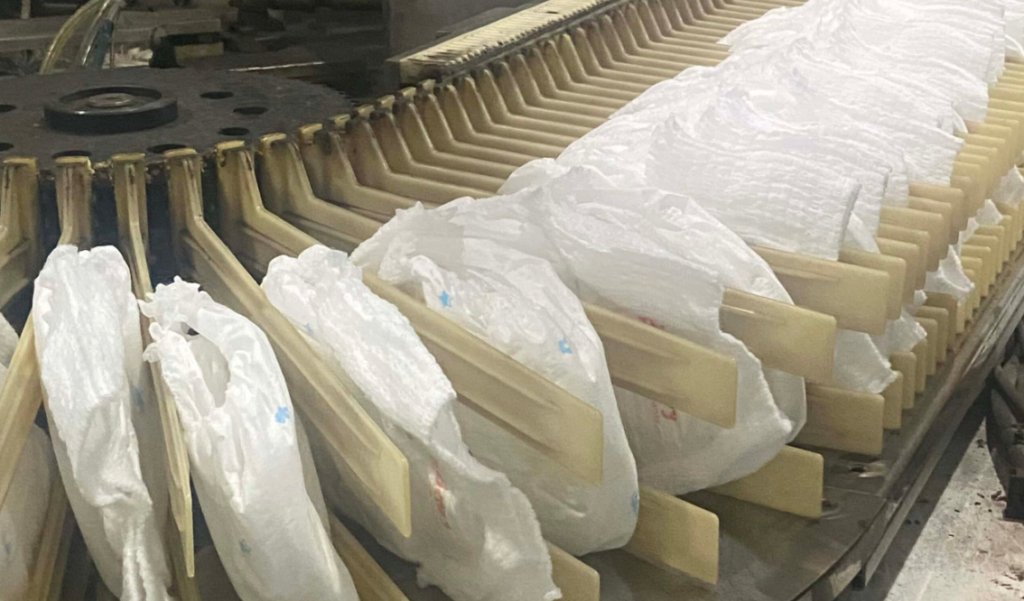Table of Contents
Starting a diaper factory is more than just setting up a production line — it’s entering a competitive, regulated, and opportunity-rich industry. Whether you’re building your own brand or planning OEM/ODM services, this guide walks you through every stage — from planning and equipment to certifications and cost control.
1. Conduct Market Research & Define Your Strategy
Before investing in equipment or space, understand the market gaps and customer expectations:
Are you targeting baby, adult, or eco-friendly diaper markets?
Will you focus on domestic sales, export, or private label/OEM production?
What are your competitors doing poorly that you can do better?
📌 Action Step: Use tools like Google Trends, industry databases, and buyer interviews to validate your business niche (e.g. bamboo diapers, bulk B2B contracts, hospital supply).
2. Build a Business Plan That Can Attract Capital
A professional diaper factory business plan includes:
Target customer segments (B2B, retailers, distributors)
Product positioning (eco-friendly, ultra-soft, budget)
Revenue model (direct sales, OEM, distributor network)
Cost projections (fixed vs. variable costs)
Certification, staffing, logistics, and compliance plans
📌 Pro Tip: Highlight eco-focus (if applicable) to attract grants, ESG investors, and sustainability-minded distributors.

3. Choose a Suitable Factory Location
Factors to consider:
Proximity to raw material suppliers (e.g. nonwovens, SAP, film)
Access to highway/export ports/logistics hubs
Compliance with zoning, pollution, and safety regulations
For startups, 800–1500㎡ is typically sufficient for small-scale production with 1–2 lines. Expansion capability is crucial.
🇺🇸 Best U.S. Locations to Open a Diaper Factory
| Region | Advantages | Notes |
|---|---|---|
| Texas – Dallas / Houston Area | ✅ Lower land and energy costs ✅ Central logistics hub ✅ Pro-manufacturing state policies | – Dallas–Fort Worth is a major industrial zone – Close proximity to the Mexico border for cross-border supply chains |
| Georgia – Greater Atlanta Area | ✅ Excellent transport access (rail, road, air) ✅ Strong labor pool ✅ Proximity to pulp and packaging suppliers | – Home to one of the world’s busiest airports – Strong logistics infrastructure for national distribution |
| Ohio – Columbus / Dayton Area | ✅ Manufacturing heritage ✅ Affordable labor market ✅ Access to nonwoven and polymer suppliers | – Ohio has a strong paper and hygiene product supply chain |
| North Carolina – Charlotte Region | ✅ Hub for fiber and nonwoven fabric suppliers ✅ Strong e-commerce fulfillment infrastructure | – Charlotte is a major distribution center for consumer products |
| Indiana – Indianapolis Area | ✅ Central U.S. location ✅ Business-friendly policies ✅ Cost-effective industrial land | – Good highway connectivity and government incentives for manufacturers |
4. Invest in Machinery: Know Your Production Line
Your equipment configuration will vary depending on product type:
| Equipment | Purpose |
|---|---|
| Fluff pulp/SAP feeding | Absorbency layer assembly |
| Elastic waistband attachment | Comfort & leak control |
| Tape & fastening applicators | Closure systems |
| Packaging automation | Individual pack sealing, labeling |
| Quality control systems | Optical checks, defect sorting |
📌 Estimated investment: $250,000 – $500,000 for semi-to-fully automated lines

5. Source Raw Materials Strategically
Key materials:
SAP (super absorbent polymer) and fluff pulp
Nonwoven fabrics (topsheet, backsheet)
Elastic materials, adhesives, tapes
For eco-friendly positioning: consider bamboo fiber, PLA, and water-based adhesives. Build long-term contracts to ensure price stability and compliance.
📌 Tip: Material cost typically accounts for 35–45% of total production costs. Negotiate for volume discounts.
6. Build Your Team: Hire, Train, and Retain
Key roles to fill:
Line operators (machine handling)
QC inspectors (on-line checks)
Maintenance technicians
Warehouse staff
Office/admin staff
(Optional) In-house R&D or design for branded factories
Training cost: $3,000–$5,000 per person during initial onboarding
Salaries: Skilled line workers ~$500–$900/month in developing regions
7. Establish Quality Control & Certifications
To be competitive in B2B sales and exports, you need certifications:
ISO 9001: Quality management
ISO 14001: Environmental management
CE mark / FDA: If exporting to EU/US
SGS or Intertek product testing
📌 Budget $10,000–$40,000 for testing, certification, and audits.
8. Set Up Packaging & Logistics
Invest in automated or semi-auto packaging systems:
Sealing & folding lines
Label printers
Cartoning and shrink wrapping
Distribution models:
Direct-to-retailer
Amazon/Facebook shop
B2B container wholesale
Overseas agents/distributors
📌 Eco-brands should also consider biodegradable packaging and carbon-neutral logistics partnerships.
9. Estimate Startup Costs (Sample Breakdown)
| Category | Estimated Cost (USD) |
|---|---|
| Equipment & Setup | $250,000–$500,000 |
| Raw Material Inventory | $50,000–$100,000 |
| Certifications & Testing | $10,000–$40,000 |
| Staff Hiring & Training | $50,000–$120,000 |
| Legal/IP/Business Reg. | $5,000–$15,000 |
| Packaging + Logistics Setup | $30,000–$80,000 |
| E-commerce + Marketing | $20,000–$60,000 |
| Warehouse/Factory Rent | $2,000–$8,000/month |
| R&D (Optional) | $10,000–$50,000 |
| Total Estimate | $500,000 – $1,000,000 |
Optional: Building a Sustainable Diaper Factory
Want to position as an eco-conscious brand?
Use biodegradable topsheets, plant-based SAP, and non-toxic inks
Partner with renewable energy providers for production
Apply for government grants for waste management and low-carbon manufacturing
Market with transparency (carbon savings per diaper, certifications, social impact)
Final Tips for Success
Start lean, then expand (avoid full-line investment before confirming demand)
Focus on quality consistency — it’s what B2B buyers care about most
Track KPIs like defect rate, cost per unit, labor productivity
Be ready to adapt product specs for different markets (e.g. sizes, packaging language, certifications)
Not ready to build a factory from scratch?
If you’re looking to enter the diaper business without setting up your own manufacturing facility, consider exploring alternative models like OEM/ODM partnerships. You can learn more in our detailed guide:
How to Build Your Own Diaper Brand →

